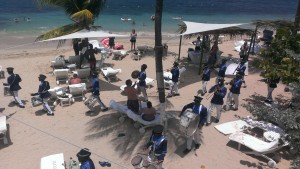The pre-crowd beach life
Laughing at my own sense of entitlement, as well as the knowledge that the bustle will slow again in a few days, makes it all right. Flashback: The ebb and flow of patients continued throughout the week. Dr. Ravi, who is the more or less the equivalent of a chief resident, was very patient and helpful navigating the system. We had some excellent discussions regarding differences in admission criteria in and among hospitals in the US, Jamaica, and around the globe, as well as the finer points of “whose patient is this?”Starting the week at Port Maria A&E (accident and emergency).
In Jamaica, Good Friday and Easter Monday are both public holidays. The energetic pomp of the marching band was a welcome addition to lunch on Monday.
Yay band!
As such, it was a welcome slow vacation weekend, despite my need to relearn the skill of relaxation, which I hadn’t necessarily lost, but had partially buried under a few layers of dirty scrubs, floor tiling equipment, and board study DVDs.“Oh, THERE you are, Peter!” (Peter : relaxation)
In rediscovering relaxation, I took advantage of the free scuba lesion here to take my first ever dive. While the bulk of my attention was focused on diving techniques of “breathing”, “kicking”, and perhaps most importantly, practicing “not touching anything,” there was enough of my sensorium available to marvel at the towering coral wall to one side and the majesty of the vast blueness to the other. We explored the shallow shelf of the wall at 40 feet deep. For those that are absent diving experience, it felt like being hit with a shrink ray and thrown into a tropical aquarium in the role of the plastic diver figurine. Had we been at the site of the sunken ship (an old WWII ship that the Jamaican government elected to sink off of the north coast for scuba diving tourist purposes), the sensation would have been complete. The coral caves were marvelous and filled with bright oranges, blues, and purples. The neon yellow shock of a trumpet fish, the ponderous waggle of the horned, cow-like trunk fish, and the sneaky, sandy camouflage of a puffer fish all made appearances before our steady ascent back into the light world of air. Otherwise, the weekend passed with fine food, good friends, plenty of sun, exercise, and only a little bit of time reserved to read and study.Sunset from the deck of the Bayside Restaurant.
I had a small visitor to the villa (below). I was suspicious that he was merely freeloading and not volunteering medical services for the foundation, but as I haven’t seen him since, I haven’t been able to confront him.
The freeloader.
Yesterday, I had the unique experience of diagnosing sickle cell disease (correctly!) for the first time since medical school. The rate in Utah is low owing to a relatively homogenous population to the point that most sickle cell patients become case presentations for our residents. Unwarranted self-congratulatory pride aside, the experience of obtaining the diagnostic test and subsequently establishing appropriate follow up was simple and efficient. It is this aspect of Jamaican care that I hope others can see. While the resources are limited, they are largely put to good and effective use by those who see to their management. Present time: Sticky humidity hangs in the air this morning across the island in the pediatric unit of Annotto Bay as I type and wait for morning rounds to commence. One of the pediatric surgical patients who last week had his legs tied up above his head has since been cut loose and sits patiently in his crib. Until rounds start, it seems like good fun to make faces at each other. And it is.
















Connect With Us